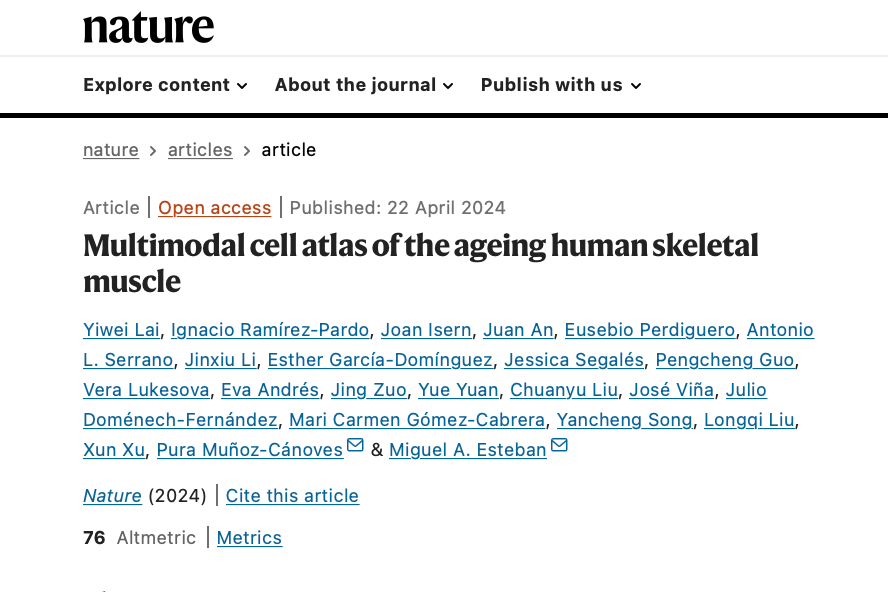-- Provides the basis for the development of preventative and therapeutic strategies in the elderly
BGI-Research, together with scientific teams from China, Spain and the U.S.A., have produced a vast single-cell atlas of human skeletal muscle, covering people aged from 15 to 99 and detailing how lower limb skeletal muscle ages in a cell-type specific manner. This breakthrough study, “Multimodal cell atlas of the ageing human skeletal muscle” was published online this week in the leading scientific journal, Nature.
 The study “Multimodal cell atlas of the ageing human skeletal muscle” was published in Nature.
The study “Multimodal cell atlas of the ageing human skeletal muscle” was published in Nature.
With rapidly ageing societies globally, diseases resulting from longevity require a detailed understanding of their causes and progression. Skeletal muscle is the key motor system in the human body and plays a pivotal role in body metabolic regulation. As age increases, particularly in individuals over 80 years old, skeletal muscles suffer from sarcopenia, a progressive loss of muscle mass and function. Sarcopenia not only increases the individual’s disability but also plays a role in the rapid decline of general functions in the elderly, making them frailer. The underlying mechanisms are not well understood. Until now, the biological basis of sarcopenia at single-cell level had not been investigated systematically.
Scientific research teams from BGI-Research, Pompeu Fabra University (UPF) in Barcelona (Spain), Altos Labs in San Diego (U.S.), Valencia University, Hospital Clínico and Hospital Arnau de Vilanova in Valencia (Spain), The First Affiliated Hospital of Guangdong Pharmaceutical University, Guangzhou Institutes of Biomedicine and Health (Chinese Academy of Sciences), and other institutions, used single-cell/single-nucleus transcriptomics and transposase-accessible chromatin using sequencing, combined with systematic morphological staining, to analyze over 387,000 cells/nuclei in lower limb muscle biopsies.
"This is the most comprehensive single-cell atlas of ageing human skeletal muscle to date. Its achievement benefits from international collaboration and the development of massively parallel single-cell profiling technologies" said Dr. Yiwei Lai, the first author of the study and a researcher of BGI-Research.
This work describes how skeletal muscle cell populations, including both the individual nuclei in the multinucleated fibers and the mononuclear compartment, change during ageing, as well as the multi-cell networks underlying these changes. By comparing this data with genetic data, the team was also able to identify key elements that mark susceptibility to sarcopenia. This study provides a powerful resource for scientists identify cells in skeletal muscles that may be amenable to medical, pharmacological, and lifestyle interventions. This could impact body health at other levels and contribute to extend lifespan.
Human skeletal muscle is largely made up of muscle fibers (myofibres), of which there are two types. Type 1 muscle fibers are primarily involved in endurance physical activity such as long-distance running or cycling. They are characterized by a slow muscle contraction speed, high aerobic metabolism, and rich mitochondria activity.Type 2 muscle fibers are important in physical activities that require sudden bursts of power such as jumping, sprinting and weight-lifting. They have faster muscle contraction rates, are more prone to fatigue and rely mainly on anaerobic metabolism to produce energy.
The researchers found that as humans age, type 2 muscle fibers deteriorate steadily during the ageing process, while type 1 muscle fibers remain relatively stable and have a better tolerance of the stress of ageing. The research also revealed that type 1 muscle fibers undergo metabolic reprogramming toward a more glycolytic phonotype during the ageing process, which may balance the oxidation of type 1 muscle fibers. Importantly, novel pro-regenerative and pro-degenerative myofiber subtypes emerged upon ageing. These new populations may be instrumental in inducing the degenerating cascade of the ageing muscle and are likely targets for intervention.
Muscles can repair themselves. This is mostly done by muscle stem cells (satellite cells) that upon injury begin to proliferate and differentiate into muscle, fusing with each other or with existing muscle fibers to repair damaged muscles. The researchers found that these stem cells exit the quiescent state in ageing muscles and enter a premature priming state, resulting in a reduced regeneration capacity.
Meanwhile, during ageing, endothelial cells also undergo changes with increased pro-inflammatory and chemotactic signals, while immune cells increase in number and initiate inflammatory programs. These changes make muscles more susceptible to deterioration in response to injury and may promote systemic inflammation and accelerate the decline of overall physical function in older people.
In addition, through cross-comparison with genetic data, the researchers identified cell-type-specific sites in chromatin, the mixture of DNA and proteins that form chromosomes in human cells, associated with susceptibility to sarcopenia. These findings provide researchers with potential new targets for future diagnosis and treatment of sarcopenia.
“Our single nucleus RNA-sequencing (RNA-seq) analysis has allowed the possibility of studying cell populations that could not be characterized by conventional single cell RNA-seq, such as myonuclei from the multinucleated skeletal muscle fibers”, said Ignacio Ramírez-Pardo, one of the co-first authors of this study, from UPF and Altos Labs.
Another relevant contributor to the study, Dr. Joan Isern from Altos Labs, indicated that “it will be relevant to compare this human muscle ageing atlas with previous cell atlases from non-human primates and from other species, as it will help establish interspecies adaptive comparisons and predict disease susceptibility”.
Dr. Pura Muñoz-Cánoves, one of the two co-corresponding authors of this study, currently Principal Investigator at Altos Labs in San Diego, said: “Our joint scientific research provides a new perspective to understand human skeletal muscle ageing and an exciting scientific basis for the development of preventative and therapeutic strategies.”
This study demonstrates the importance of international cooperation and multidisciplinary teamwork in addressing critical scientific challenges. Through a deeper exploration of muscle degeneration in various contexts, the research team aims to build a more comprehensive atlas of to improve the understanding of muscle function in tackling the challenges faced by ageing societies.
The study can be assessed here: https://www.nature.com/articles/s41586-024-07348-6



